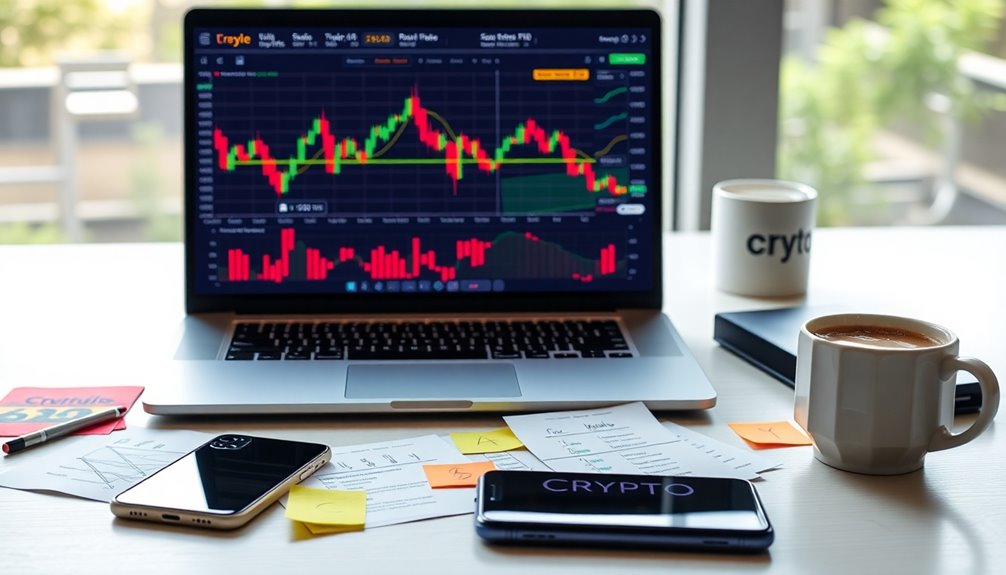If you're curious about how crypto trading works, you're not alone. Many people want to understand this dynamic market filled with opportunities and risks. It all starts with choosing a reliable exchange and setting up your account. But what comes next? How do you navigate the complexities of buying, selling, and managing your investments? Let's break it down step by step to give you the clarity you need.
Key Takeaways
- Crypto trading involves buying and selling digital currencies, either in the spot market or through derivatives for speculation on price movements.
- Choose a cryptocurrency exchange like Crypto.com, Coinbase, or Kraken to start trading, considering their fees and available currencies.
- Create and verify your account by providing personal information and funding it with fiat or cryptocurrencies while ensuring security measures are in place.
- Develop a trading plan that includes research on cryptocurrencies, technical and fundamental analysis, and risk management strategies like stop-loss orders.
- Stay informed about market volatility, trading fees, and regulatory changes that may impact your trading experience and decisions.

As you delve into the world of cryptocurrencies, understanding the basics of crypto trading is essential. Crypto trading is the process of buying and selling digital currencies like Bitcoin and Ethereum on various online platforms. You can engage in trading through the spot market, where you’re actually buying and selling the coins, or through derivatives, which allow you to speculate on price movements without owning the coins directly. Additionally, selecting the right platform is crucial for successful trading. A crypto exchange explained will detail how these platforms operate, the fees associated with transactions, and the security measures in place to protect your investments. Understanding these factors can help you make informed decisions and navigate the dynamic landscape of cryptocurrency trading effectively.
Market movements in the cryptocurrency space can be quite volatile, driven primarily by supply and demand. Prices fluctuate based on multiple factors, including market sentiment, news events, and the overall adoption of cryptocurrencies. You'll want to familiarize yourself with both technical and fundamental analysis as these tools can help you understand price trends and make informed trading decisions. Additionally, cryptocurrency trading can involve significant risk due to the asset's volatility.
When choosing to trade, you must also consider trading fees, which can vary significantly from one exchange to another. For instance, some platforms may charge fees as low as 0.16%, while others might go as high as 3.49%. It's crucial to factor in these costs when planning your trades, as they can impact your overall profitability.
Additionally, be aware that the regulatory environment surrounding crypto trading is evolving. Some exchanges have faced legal scrutiny, which can affect their operations and your trading experience.
To start trading, you'll need to select a cryptocurrency exchange. Popular options include Crypto.com, Coinbase, Gemini, Kraken, and Binance.US, each offering unique features. For example, Crypto.com boasts over 350 cryptocurrencies and low fees, while Coinbase provides access to over 200 coins but has a spread markup that you should consider.
If you're an advanced trader, Gemini might be appealing due to its selection of crypto-to-crypto trading pairs. Kraken is known for its low fees and extensive selection, although it's not available in some states like New York or Washington. Binance.US also has a wide array of cryptocurrencies with fees that decrease as your trading volume increases.
Once you've chosen an exchange, you'll need to open an account. This typically involves creating a profile, verifying your identity, and funding your account with either fiat currency or cryptocurrencies. Be sure to check if the exchange has any minimum balance requirements and familiarize yourself with deposit and withdrawal fees.
Security is paramount, so look for exchanges that implement robust measures such as two-factor authentication and cold storage for your digital assets.
Lastly, developing a solid trading plan is vital for success. Conduct thorough research on the cryptocurrencies you're interested in, including their whitepapers and market trends. Use technical analysis tools like order books to gauge market structure and make informed decisions.
Incorporate fundamental analysis by considering supply and demand dynamics and any regulatory changes that may impact your trades. Remember to implement risk management strategies, such as setting stop-loss orders, to protect your investments.
Frequently Asked Questions
What Are the Tax Implications of Crypto Trading?
When you trade cryptocurrencies, you need to consider several tax implications.
Selling, trading, or using crypto as payment triggers taxable events, where gains or losses are calculated based on your purchase and selling prices.
Income from mining or staking is taxed as ordinary income.
You'll report these transactions on Form 8949, so keep detailed records.
Always consult a tax professional to ensure compliance with regulations and to optimize your tax strategy.
How Can I Securely Store My Cryptocurrency?
Think of your cryptocurrency like a treasure chest. To keep it safe, you need a strong lock.
Start by using hardware wallets for offline storage, ensuring your private keys are encrypted. Implement strong passwords and multi-factor authentication for added security.
Regularly back up your wallet and store recovery phrases securely. Avoid public Wi-Fi, and consider using a VPN when accessing your wallet to protect your valuable assets from prying eyes.
What Are Common Trading Strategies for Beginners?
When you're starting out in trading, common strategies include day trading, swing trading, scalping, and long-term investing.
Day trading involves quick buy-sell actions within a day, while swing trading allows you to hold positions for several days.
Scalping focuses on making many small trades for quick profits. Long-term investing is about holding assets for extended periods.
Each strategy has its pros and cons, so choose one that matches your risk tolerance and lifestyle.
How Do I Choose a Reliable Crypto Exchange?
When diving into the crypto sea, choosing a reliable exchange is your lifeboat.
Start by checking security measures like two-factor authentication and cold storage. Look for a platform with a solid uptime track record and a wide range of supported cryptocurrencies.
Prioritize user-friendly interfaces and responsive customer support.
Lastly, research the exchange's reputation and compliance with regulations to ensure your assets stay safe while you navigate the trading waters.
Can I Trade Crypto on My Mobile Device?
Yes, you can trade crypto on your mobile device! Many platforms offer mobile apps, allowing you to buy, sell, and manage your crypto portfolio on the go.
Apps like Coinbase, Gemini, and OANDA provide user-friendly interfaces and essential trading features. You'll also find security measures like two-factor authentication to protect your account.
With these apps, you can easily make trades whenever and wherever you want. So, get started and trade confidently!
Conclusion
In the wild world of crypto trading, you're the captain of your own ship. With the right tools and knowledge, you can navigate the turbulent waters of volatility and seize golden opportunities. Remember, the market's waves can be unpredictable, so stay sharp and keep your strategy close. As you set sail on this digital adventure, trust your instincts and rise above the tide—your journey in the crypto realm is just beginning!









